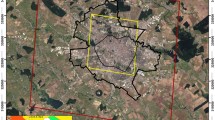Abstract
The present study aims to investigate the kinematic behaviour of slow-moving landslides affecting urban areas at municipal scale, based on remote sensing meteorological and displacement (DInSAR) historical data. The long-term influence of weather patterns on landslide dynamics and their potential variation under the effect of ongoing climate change is taken into account through the reanalysis of the main weather and soil water variables derived by the freely available datasets provided by CERRA within the Copernicus Climate Change Service (C3S). The above-mentioned data are jointly analysed with widespread ground surface displacements data gathered from the processing of very-high resolution Synthetic Aperture Radar (SAR) images acquired by COSMO-SkyMed constellation via Differential Interferometry (DInSAR) techniques. The link between the main weather and soil water variables with the ground deformations sensed from the space was investigated in the territory of Vaglio Basilicata, a municipality in the Basilicata region (southern Italy) widely affected by slow-moving landslides interacting with the built-up environment and, specifically, infrastructure networks. The preliminary results achieved could be valuably used as input to outline a proper procedure aimed at the dynamic evaluation of the infrastructure risk associated with weather-induced reactivations and/or accelerations of slow-moving landslides.
Access this chapter
Tax calculation will be finalised at checkout
Purchases are for personal use only
Similar content being viewed by others
References
Corominas, J., et al.: Recommendations for the quantitative analysis of landslide risk. Bull. Eng. Geol. Environ. 73(2), 209–263 (2014)
Peduto, D., Nicodemo, G., Caraffa, M., Gullà, G.: Quantitative analysis of consequences to masonry buildings interacting with slow-moving landslide mechanisms: a case study. Landslides 15(10), 2017–2030 (2018). https://doi.org/10.1007/s10346-018-1014-0
Ferlisi, S., Marchese, A., Peduto, D.: Quantitative analysis of the risk to road networks exposed to slow-moving landslides: a case study in the Campania region (southern Italy). Landslides 18(1), 303–319 (2020). https://doi.org/10.1007/s10346-020-01482-8
Leroueil, S.: Natural slopes and cuts: movement and failure mechanisms. Géotechnique 51(3), 197–243 (2001)
Hungr, O., Corominas, J., Eberhardt, E.: Estimating landslide motion mechanism, travel distance and velocity. In: Hungr, O., Fell, R., Couture, R., Eberhardt, E. (eds.) Landslide Risk Management, pp. 99–128. Taylor and Francis, London (2005)
Peduto, D., Ferlisi, S., Nicodemo, G., Reale, D., Pisciotta, G., Gullà, G.: Empirical fragility and vulnerability curves for buildings exposed to slow-moving landslides at medium and large scales. Landslides 14(6), 1993–2007 (2017). https://doi.org/10.1007/s10346-017-0826-7
Schimanke, S., et al.: CERRA sub-daily regional reanalysis data for Europe on single levels from 1984 to present. Copernicus Climate Change Service (C3S) Climate Data Store (CDS) (2021). https://doi.org/10.24381/cds.622a565a. Accessed 18 Jan 2023
Buontempo, C., et al.: The copernicus climate change service: climate science in action. Bull. Am. Meteorol. Soc. 103(12), E2669–E2687 (2022)
Hersbach, H., et al.: The ERA5 global reanalysis. Quart. J. Roy. Meteor. Soc. 146, 1999–2049 (2020)
Peduto, D., Santoro, M., Aceto, L., Borrelli, L., Gullà, G.: Full integration of geomorphological, geotechnical, A-DInSAR and damage data for detailed geometric-kinematic features of a slow-moving landslide in urban area. Landslides 18(3), 807–825 (2020). https://doi.org/10.1007/s10346-020-01541-0
Jovanovski, M., et al.: Landslide characterisation in the Polog region by innovative and conventional methods. Italian Geotech. J. 4, 7–31 (2021)
Nicodemo, G., Ferlisi, S., Peduto, D., Aceto, L., Gullà, G.: Damage to masonry buildings interacting with slow-moving landslides: a numerical analysis. In: Calvetti, F., et al. (eds.) CNRIG 2019. LNCE, vol. 40, pp. 52–61. Springer, Cham (2020). https://doi.org/10.1007/978-3-030-21359-6_6
Vecchiotti, F., Amabile, A.S., Clemente, S., Ostermann, M., Nicodemo, G., Peduto, D.: Kinematic and geometric characterization of the Vögelsberg Rockslide (Tyrol, Austria) by means of MT-InSAR data. Geosciences 12, 256 (2022)
Ardizzone, F., et al.: A Procedure for the quantitative comparison of rainfall and DInSAR-based surface displacement time series in slow-moving landslides: a case study in southern Italy. Remote Sens. 15(2), 320 (2023)
Zhong, L., Jinwoo, K.: A framework for studying hydrology-driven landslide hazards in northwestern US using satellite InSAR, precipitation and soil moisture observations: early results and future directions. GeoHazards 2(2), 17–40 (2021)
Sdao, F., Simeone, V.: Mass movements affecting Goddess Mefitis sanctuary in Rossano di Vaglio (Basilicata, southern Italy). J. Cult. Herit. 8, 77–80 (2007)
Acknowledgements
This research has been supported by MIUR PON R&I 2014–2020 Program (project MITIGO, ARS01_00964). The authors wish to acknowledge project partner e-GEOS for processing the COSMO-SkyMed data. CERRA data was downloaded from the Copernicus Climate Change Service (C3S) Climate Data Store. Neither the European Commission nor ECMWF is responsible for any use that may be made of the Copernicus information or data it contains.
Author information
Authors and Affiliations
Corresponding author
Editor information
Editors and Affiliations
Rights and permissions
Copyright information
© 2023 The Author(s), under exclusive license to Springer Nature Switzerland AG
About this paper
Cite this paper
Nicodemo, G. et al. (2023). Remote Sensing Meteorological and DInSAR Historical Data to Analyse the Kinematic Behaviour of Slow-Moving Landslides at Municipal Scale. In: Ferrari, A., Rosone, M., Ziccarelli, M., Gottardi, G. (eds) Geotechnical Engineering in the Digital and Technological Innovation Era. CNRIG 2023. Springer Series in Geomechanics and Geoengineering. Springer, Cham. https://doi.org/10.1007/978-3-031-34761-0_30
Download citation
DOI: https://doi.org/10.1007/978-3-031-34761-0_30
Published:
Publisher Name: Springer, Cham
Print ISBN: 978-3-031-34760-3
Online ISBN: 978-3-031-34761-0
eBook Packages: EngineeringEngineering (R0)




